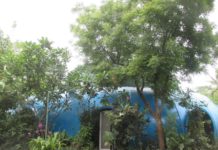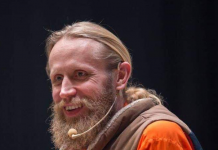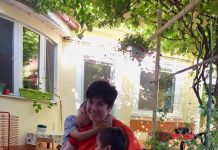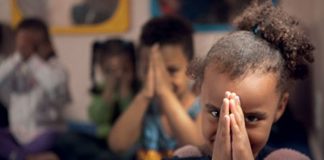Yogatherapy course unites Tantra, somatic practices, and nature in the Northeast of Brazil
The body as a beautiful and sacred entrance to spiritual growth. As an extension of nature. As the stage on which the cosmic play can take place. As a space to come in contact with our human condition. As a place for self-knowledge, to grow roots, to flow. It is to inhabit this body that we are invited to the training course in yogatherapy, created by Acarya Vishvarupananda Avadhuta and Jayadevi (Germana Lucena), now also led by Maetreyii (Cris Ibiapina).
The course is composed of four immersive modules and online meetings. The first module lasts five days, and the others, six days, making altogether 220 face-to-face hours and and additional 80 online hours. The face-to-face meetings take place by the sea at the Hotel Bitingui in Japaratinga/AL, in the Northeast of Brazil. There the participants perform their physical practices and attend lectures and workshops, both in the hall and out of doors, with the sun, sand, waves and ocean breeze. Indeed, the kiirtan and meditation sessions take place on the beach.
“Yogatherapy is just beginning in Brazil. There are two strong movements here: Hormonal Yogatherapy, led by Dinah Rodrigues https://www.dinahrodrigues.com.br/home-pt , and Integrative Yogatherapy, of which one of the strongest representatives is the Montanha Encantada http://www.yogaencantada.org/ (Enchanted Mountain, free translation) in Santa Catarina”, says Jayadevi. According to her, what is innovative about her course is the introduction of Anandamurti’s principles of Tantra (put together by Dada), along with the somatic practices of Feldenkrais (taught by her) and Embodiment (brought by Maetreyii). “What captivated me most in this work was the possibility of using yoga not only as postures, but as gestures and attitudes that are incorporated into our daily life,” says Maetreyii.
The presence of Tantra can be seen in both theory and practice. The participants have daily asana classes, maintaining the essence of the Ananda Marga system, and enriching it with somatic practices and Hatha Yoga exercises, among others. They also perform dharmacakra (kiirtan, meditation, kaoshikii, and tandava) twice a day, by the ocean.
In the conceptual part, three aspects of Tantra are focused on: the kosas (the layers of the mind), the philosophy of tantric anatomy, and the notion of liila (cosmic play). The concept of kosas, for example, “shows the human being as a spectrum that goes from body to soul,” as Dada Vishvarupananda states. “One who is healthy is open to the Supreme Consciousness and allows this to flood every aspect of their being.”
Tantric philosophy views the body as “the greatest instrument we have on this planet.” Therefore, according to Dada, behind physical and psychic sufferings, there is the criticism or denial of the body or detachment from it. “The body is an expression of nature and corresponds to its elements. We look at it as a means to bring out the aesthetic beauty of Tantra, as a canvas on which we can paint the beauty of life,” he says. Therefore, he points out, Tantra uses visualizations and mantras to transform our way of looking at the body, beyond “flesh and blood, but as a deep cosmic expression.”
The idea of liila (cosmic play) reminds us that “the healthy, the sick, the young and the old age are all expressions of this play”. According to Dada, many illnesses arise because of too much self-centeredness, and the notion of liila reconnects us with the idea of dancing a cosmic dance that “sometimes takes on more comical tones, sometimes more tragic.” He says that liila refers to the energy of the child, who is always in the present, without planning the future or dwelling on the past.
Somatic practices, according to Jayadevi, are brought in as adjuncts to help the participant “enter into the experience of the sacredness of the body.” “Body work opens up a faster access route for when Tantra is introduced,” she says. Both she and Maetreyii believe that the goal is to get the participants to deepen their relationship with their body, to find within themselves resources for healing and self-knowledge, so that they can then support others, through therapeutic work.
Since its inception in 2016, 59 people have already enrolled in the course, of which 25 have completed the four modules. The others are still in training, or are participating in the new class, which started in May of this year. Those who have completed the course can act as yogatherapists, using the practices and concepts of yoga in the auxiliary treatment of physical and psychic illnesses. “We want to spread the seeds of Tantra through yogatherapy,” says Jayadevi.
And it looks like they are succeeding. Rainjanii (Rafaela Müller), who travels from the interior of São Paulo to participate in the modules in Alagoas, says that the course gave her “diversified resources that are anchored in the philosophy of Baba, so that yoga can be accessible to those who are familiar with it as well as those who are not, and to support specific health issues that are not always easy to deal with. It has been a great inspiration.”
Learn more about the course by writing to manalucena@hotmail.com or +55 83 99634-3800 (WhatsApp), and fanpage: https://www.facebook.com/Yogaterapia-e-Pr%C3%A1ticas-Som%C3%A1ticas-2041567569461108/







